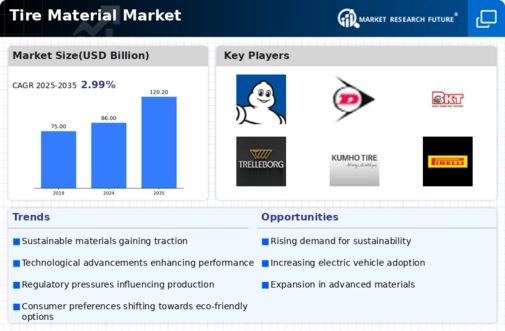Top Industry Leaders in the Tire Material Market

The tire material market is silently powering the world's vehicles with a complex symphony of rubber, steel, and other components. But beneath the tread, a fierce competition rages, with established giants and innovative newcomers vying for dominance. To understand this dynamic landscape, we must delve into the strategies, market share factors, industry news, and recent developments shaping its trajectory.
Key Players and Their Strategies:
-
Bridgestone (Japan): The world's largest tire manufacturer, Bridgestone leverages its global scale and brand recognition to secure a significant market share. Their focus on R&D, particularly in eco-friendly materials like Enliten natural rubber, keeps them ahead of the curve. -
Michelin (France): Michelin, another tire titan, relies on its premium positioning and technological prowess. Their focus on fuel efficiency and performance through silica-based tread compounds attracts high-end customers. -
Continental AG (Germany): Continental takes a diversified approach, catering to various vehicle segments with specific tire materials. Their ContiRe.Tex® technology, using recycled polyester in tire cords, exemplifies their sustainability commitment. -
Sumitomo Rubber Industries (Japan): Sumitomo Rubber, known for its Falken and Dunlop brands, focuses on cost-effectiveness and regional expansion. Their strategic partnerships in emerging markets like China and India drive their market share growth. -
Lanxess (Germany): While not a tire manufacturer, Lanxess plays a crucial role by supplying high-performance rubber additives and reinforcing materials. Their focus on innovation and sustainability attracts leading tire companies as partners.
Factors Shaping Market Share:
-
Technological Innovation: Developing next-generation materials like self-healing rubber, lightweight composites, and puncture-resistant treads provides a competitive edge. -
Sustainability: The rising demand for eco-friendly tires pushes manufacturers towards bio-based materials, recycled content, and energy-efficient production processes. -
Regional Demand: Expanding into high-growth regions like Asia and Latin America unlocks new customer segments and market potential. -
Cost Optimization: Efficient supply chain management, optimizing material usage, and reducing production costs are crucial for profitability in a competitive market. -
Strategic Collaborations: Partnerships with research institutions, material suppliers, and vehicle manufacturers accelerate innovation and market penetration.
The key players of tire materials market are
- Orion Engineered Carbons
- Royal Dutch Shell
- China Petroleum & Chemical Corporation
- Chevron Corporation
- Nynas AB
- Petro China Company Limite
- Exxon Mobil Corporation
- SIBUR INTERNATIONAL
- American Zinc Recycling LLC,
- PPG Industries
- Ralson Goodluck Carbon
- Longxing Chemical, Phillips
- S. Zinc.Inc
- SRF Limited
- Australian Tyre Traders
- Umicore SA
- TEIJIN ARAMID B.V.
- Aeolus Tyre Co., Ltd.
- Metro Tyre
Recent Developments:
-
October 2023: Lanxess launches a new line of bio-based rubber additives, opening doors for tire manufacturers seeking sustainable solutions. -
November 2023: Bridgestone and Michelin collaborate on a research project to develop self-healing tire technology, aiming to revolutionize the tire industry. -
December 2023: A startup unveils a new tire manufacturing process that uses 3D printing technology, potentially disrupting the traditional tire production model.










